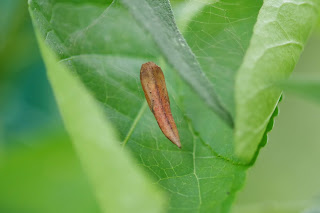Today's bug walk provided a tiny thrill in the form of something I have never witnessed before. There are great and iconic things I have been privileged to see in my life, things I've heard about and read about, and dreamed of seeing, like the Grand Canyon, and then there are tiny things that I have also read about, and dreamed of seeing, that maybe don't rise to the grandeur of the Grand Canyon, but are just as awesome (in the sense of actually creating awe), but on a tiny scale. For me, at least.
And that is what happened with today's Backyard Bug of the Day:
Insects that don't undergo complete metamorphosis, and that includes all of the Hemiptera, go through a series of instars, and in between each they molt, emerging from their old "skin" larger and more developed. When they molt for the last time they will emerge with their fully developed wings, finally, and will be imagos, or adults. They won't grow anymore after that, but they will have reached sexual maturity, and can reproduce (except for aphids, which are born ready to give birth to young, apparently. It's complicated). Anyway, I know all of this, and I often find evidence of the process in my backyard, in the form of exuvia, or the discarded exoskeletons that insects leave behind when they molt. But I have never seen it happen... until today (except for monarch caterpillars that I was raising in the house, and they do go through complete metamorphosis, so when they molt they are the same as they were, just bigger and wrinklier). I found this leaf-footed bug in the process of its final molt. Now, I didn't see the whole thing, and in fact didn't see anything actively happening–it was as you see in the picture when I found it, almost completely emerged from its old skin. But that was still exciting to me. You can see that the wings are not fully expanded yet, and the pink color is temporary–often when insects molt I think they are a paler color than they will be.
Here you can see better the old exoskeleton it is coming out of. I left it at this point, planning to come back and check on it when I finished my bug walk, which I did, but it was gone by then (about an hour later). I had hoped the bug would stick around for a while, and I would get to see how it looked–I assume it would have darkened to brown, and the wings would be straight–but I guess it had flown away. It wasn't on the plant, or any nearby. Oddly, the exuvia was gone, too. Caterpillars eat theirs, but a Hemiptera couldn't do that, they drink liquids through their tube-like mouths. Still, this was an exciting backyard find for me. If you want to know what this bug looked like before, I took a picture of it two days ago, so it's part of that blog post.
Other Bugs:
The autumn joy sedum has started to bloom, and has been attracting a lot of bumblebees.
I found several banded tussock moth caterpillars today:
Tucked into a gap in tree bark.
Actually in a small hole in a tree.
As you can see, banded tussock moth caterpillars have several color variants.
Orthoptera have figured prominently in my blog the last few days, including a day when I featured them as a group, highlighting the variety to be found in my backyard. To my annoyance, there are several more species that I "missed" that day, that are now showing up, to which I say...
Where were you two days ago, cricket!
I saw this one the day before I made that post, and I found it again today.
Immature tree cricket, totally white (an uncooperative).
I found another conehead katydid:
This one is a juvenile, as seen in the undeveloped wings, and a female–not the incredibly long ovipositor.
This is to be the last picture of this katydid, who has been hanging around in the same spot for over a week, just reaching imago stage a couple of days ago. It was there in the morning when I did my bug walk, but by late afternoon it was gone.
There are a LOT of these katydids in my backyard, mostly in three specific flowerbeds, including this one, which is where the black-eyed Susans are.
Who's there?
Tree cricket!
These are all over the backyard, too. Possibly several similar species, I can't really tell.
Sawfly larva
Some kind of Hemiptera nymph
Tiny wasp
Chrysalis
Stinkbug nymph
Fly
Geometer/looper caterpillar
I should have taken a picture of this yesterday when I focused on the color green and insects blending in, but I didn't plan that blog theme ahead of time, and I have taken a lot of pictures of these over the last few weeks.
What I didn't notice when I took the picture is the mating weevils on the vine. I missed the obvious in looking at the unobvious.
Hopper nymph. Sometimes when I get close to hoppers with my camera they do something that I kind of suspect is supposed to be a defensive move...
They eject a drop of honeydew. I suspect that is because they know some animals feed on it, and hope that by giving them what they want they will be left alone. I don't personally drink insect secretions for nourishment, so it's wasted on me if that's why they do it. Anyway, here you can see one of the drops this hopper shot at me.
The monarch caterpillars in the milkweed patch keep disappearing, and sometimes reappear...
Ambush bug
Arachnid Appreciation:
.
.
.
.
.
.
.
.
.
.
.
.
This spider is still in the same spot it was yesterday... or was it the day before?







































No comments:
Post a Comment